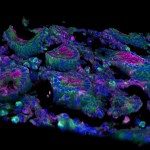Lien vers Pubmed [PMID] – 25324284
Invest. Ophthalmol. Vis. Sci. 2014 Dec;55(12):7761-74
PURPOSE: To compare the biological patterns of viral transcripts during herpes simplex virus type 1 (HSV1) latent infection according to experimental conditions.
METHODS: Two types of murine models of HSV1 infection were used: the corneal scarification model, often used in studies of HSV1 latency, and the oro-ocular murine model. Two strains of HSV1 were used for the inoculation: SC16, a wild type strain considered as highly neuroinvasive, and KOS, previously described as poorly neurovirulent. The amounts of viral genomes, and those of four types of viral transcripts (immediate-early, early and late, together with latency-associated transcripts [LATs]), were measured by quantitative PCR and RT-PCR in the main sites of HSV1 latent infection at 6 days, 1 and 3 months post inoculation, and the number of LAT-expressing neurons was assessed by in-situ hybridization on histological sections of trigeminal ganglia (TG).
RESULTS: Using the SC16 strain of HSV1 in the oro-ocular model, immediate-early transcripts were still present at 1 month post inoculation (early stage of latent infection), but were not detected at 3 months (late stage of latent infection). In both cases, early and late viral genes transcripts were not detected, demonstrating the latent nature of the infection with this combination of experimental conditions. In contrast, such progress in the viral gene expression was not observed in the corneal scarification model, particularly when the KOS strain of HSV1 was used.
CONCLUSIONS: These results highlight that the behavior of the virus in the nervous system depends on the method inoculation, and the viral strain. All these parameters are likely to influence the establishment of latent infection.

